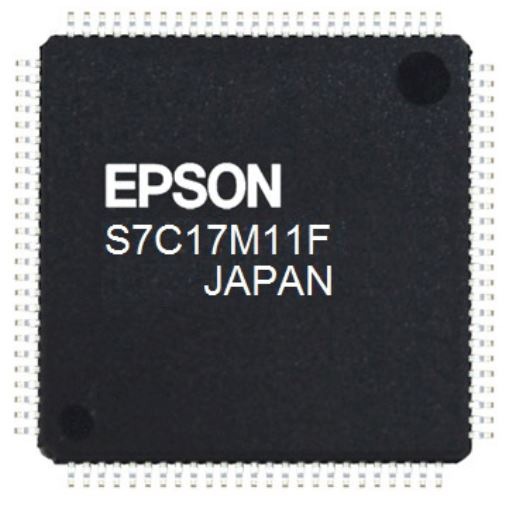The S7C17M11 is ideal for applications requiring accurate timekeeping and control under harsh temperature environments
Seiko Epson Corporation has begun shipping samples of the S7C17M11, a low-power 16-bit microcontroller with on-chip Flash memory, a crystal unit, and a highly accurate real-time clock (RTC) with a temperature compensation function. Epson plans to produce an initial 300,000 units per month when volume production beings in January 2017.

Precise timekeeping is important for many microcontroller equipped devices such as electricity meters. Accurate meters are essential, for example, in the many countries and regions where power companies charge different rates depending on the time of day. Epson, which boasts both a semiconductor and a quartz crystal device business, has leveraged its strengths to integrate a crystal unit into the S7C17M11 microcontroller package that allows customers to develop accurate timekeeping efficiently even under harsh environmental conditions, such as in outdoor meters.
An ordinary RTC consists of a timekeeping IC that is connected to an external crystal unit. Time is measured based on the frequency of the crystal unit. However, the stability of the crystal unit's oscillation frequency varies by product. Frequency stability, and thus accuracy, is also affected by the temperature of the environment in which it is used. For this reason, when a microcontroller is used in a harsh environment with extreme temperatures or extreme temperature fluctuations, users had to take into account deviations in oscillation frequency caused by temperature changes when they designed their end-products, and sometimes they were unable to achieve the desired timekeeping accuracy.
To address this situation, Epson integrated one of its own high-stability crystal units into the S7C17M11 microcontroller package and developed technology for detecting and correcting frequency deviations caused by temperature changes. The S7C17M11 is accurate to within 10 seconds per month at temperatures between 0 °C and 50 °C, 13.2 seconds per month between –30 °C and 70 °C, and 26.4 seconds per month between –40 °C and 85 °C. Moreover, this integrated, single-chip solution eliminates the need for adjustments, thus reducing customers' development time and reducing the number of discrete components.
The S7C17M11 has a number of other integrated peripheral circuits, including but not limited to Flash memory, a 12-bit AD converter, and an LCD driver with a built-in liquid crystal power supply for a 240-segment display. Power consumption in RTC mode is 2.25 µA (typical).
Key product features
- Built-in circuits that will reduce the number of components in customers’ products, save board space, and shrink software development times
- A high-accuracy RTC with temperature compensation and a built-in 32.768 kHz crystal unit
- A 12-bit successive-approximation AD converter that enables connection of common voltage output analog sensors
- An LCD driver that can directly drive an LCD with up to 240 segments
- A power switching circuit that monitors the main power supply voltage and can switch to a backup power supply as needed
- Built-in oscillator circuits (32.768 kHz and 700 kHz fixed-frequency circuits and a circuit that is switchable between 16 MHz, 12 MHz, 8 MHz, and 4 MHz)
- A supply voltage detector (SVD) circuit that does not require an external power supply supervisor and is accurate to ±2.5% (–40 °C to 85 °C)
- A sound generator that supports three octaves, seven notes, and seven rests
- An IR remote controller capable of infrared remote control output
- Interfaces for communicating with cards or connecting to a variety of sensors and devices
- Equipped with four types of serial interfaces: UART, SPI, I2C, and a smart card interface (ISO 7816-3 compliant)
- Universal port multiplexers that increase board layout design flexibility
Product specifications
- Product model number: S7C17M11
- CPU core: 16-bit RISC processor + multiplier/divider
- Flash memory: 128 kilobytes
- RAM: 8 kilobytes
- Operating voltage: Guaranteed operating range: 2.5 V - 3.6 V
- Current consumption:
- SLEEP Mode (RTC Mode ON): 2.25 μA (typical)
- RUN Mode (32.768 kHz): 8 μA (typical)
- RUN Mode (8 MHz): 1,500 μA (typical)
- 32.768 kHz frequency stability:
- 0 °C to 50 °C: ±3.8 × 10–6 (monthly rate ≤ 10 sec)
- –30 °C to 70 °C: ±5 × 10–6 (monthly rate ≤ 13.2 sec)
- –40 °C to 85 °C: ±10 × 10–6 (monthly rate ≤ 26.4 sec)
- LCD driver:
- 136 segments max. (34 SEG × 4 COM)
- 192 segments max. (30 SEG × 6 COM)
- 240 segments max. (30 SEG × 8 COM)
- I/O ports: 42 max.
- Analog-digital converter: 8 inputs (12-bit successive-approximation ADC)
- Supply voltage detector: Voltage detection accurate to ±2.5% (–40 °C to 85 °C) at 32 levels between 1.2 V and 5.0 V
- Serial interfaces:
- UART (4 ch.),
- SPI (1 ch.),
- I2C (2 ch., one of which is used to control the high-accuracy RTC),
- ISO 7816-3 compliant smart card interface (2 ch.)
- Package: H4QFP15-100 (16 mm × 16 mm; pin pitch: 0.5 mm)